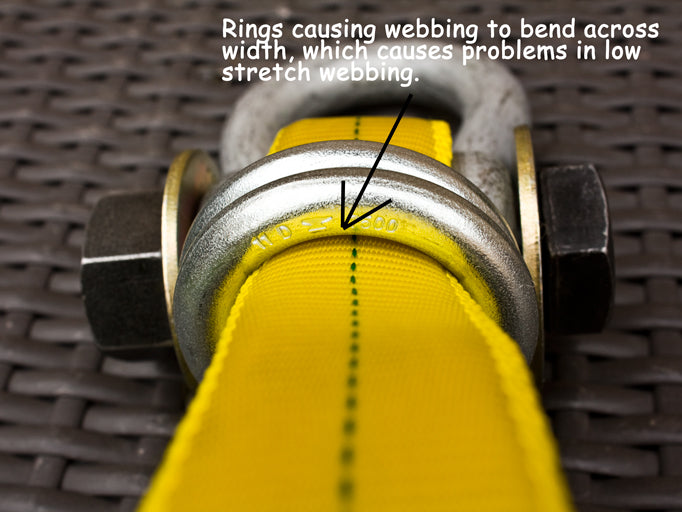You have no items in your shopping cart.
0
You have no items in your shopping cart.
Webbing Anchor's are an essential part of your slackline setup. Without them we would have to use knots with our webbing, which can very easily destroy the webbing with very little use.
A Webbing Anchor is a device used to attach your webbing to your anchor. There are several types of Webbing Anchor's on the market, all with unique features that allow for different functionality.
The most important features of a webbing anchor are the strength (MBS) of the device, the webbing strength retention (how much of the webbing's strength is retained when anchored with said device), and whether or not it is adjustable.
I'd like to look at the three types of Webbing Anchors, two of which are available in the Shop: The Shackle Line-Locker, the WebLock, and the MONSTER Lock.
The Shackle Line-Locker is a line-lockers built on one of two different types of shackles. One of the line-locker's is built on a Van Beest 5/8" Bolt-Type Anchor Shackle and is meant for the non-tensioning side of your slackline due to the large shackle size. The other one is built on the bow side of a Van Beest 1/2" Screw Pin Anchor Shackle and is meant for the tensioning side of your slackline as the smaller shackle can connect directly to any pulley system you may have.
The way a line-locker works is a bight (fold) of webbing is passed through a pair of rings and wrapped around the pin (or bow) of the shackle, back through the rings again, and then on to the pin (or bow) of the shackle. These multiple wraps around curved objects cause the webbing to bend in multiple ways which leads to non-uniform loading of the fibers across the width of the webbing. The outer fibers especially see much higher loads than the center fibers, which can cause them to become damaged quite easily. This is why when using a line-locker as a Webbing Anchor, it's very important to use a line-sleeve to protect the line from damage.

Notice in the above picture that the webbing forced to bend when passing through the rings, then is forced to bend the opposite way when going around the pin of the shackle, and then again the other way when it goes through the rings again. The small parts between the changing bends experience a very large difference in tension, especially with lower-stretch webbings (such as Mantra and Spider Silk). It is recommended to not use any sort of line-locker with these lower-stretch webbings as this method can damage the line at even the smallest of loads (800-1000 lbf is a common tension to start seeing damage to the line when using line-lockers with low-stretch webbing).
However, using line-lockers with higher-stretch webbings is perfectly fine. I have seen a 98% strength retention with Type-18 in a 5/8" Shackle Line-Locker Kit. This is because the higher stretch of the nylon fibers allows the webbing to bend around curves without causing much of a difference in stretch across the width. If the outer fibers stretch 1% more than the inner fibers, it will matter much less on a webbing that has a 15% stretch compared to one that has just a 7% stretch.
The strength retention of the Shackle Line-Locker depends greatly on what type of webbing you are using. For nylon webbings, you can see as much as 90% strength retention. For polyester webbings, this number drops down to 80% (this needs further testing). For high-tech fiber webbings, such as Spider Silk MKII, the strength retention drops down as low as 50% (needs further testing). As you can see, line-lockers are best used with high-stretch webbing. When using low-stretch webbing, it's best to use WebLock type devices, as described below.
A huge advantage of line-lockers is that the components typically have amazingly high breaking strengths (typically in the 20,000 - 30,000 lbf range). This is due to the fact that they use ready made components that were meant for overhead lifting.
Line-Lockers are also non-adjustable, which makes them quite a bit harder to use as you have to correctly predict how much room to leave for tensioning when setting up your slackline.
The WebLock is an adjustable Webbing Anchor which usually works in combination with a shackle, whether on the pin or the bow.
Typically, the way that a WebLock works is that a bight (fold) of webbing wraps around the center diverter and is then connected to the front pin. This allows the webbing to be adjustable in one direction while retaining a large percentage of its breaking strength, depending on the size of the center diverter. It also keeps the webbing in good condition because there are no bends that the webbing is forced to go through.
Strength retention depends greatly on the the thickness of the webbing, the size of the center diverter, and the stretch of the webbing. When the webbing goes around the center diverter of a WebLock, the outer fibers are elongated while the inner fibers are compressed (see picture below). This causes the outer fibers to hold a higher percentage of the force compared to the inner fibers. The thicker the webbing, the greater the difference is. Also, the smaller the diameter of the diverter, the great this difference is. For nylon webbings, you can expect a 98% strength retention. Polyester webbings range from 90-98%, depending on the thickness. High-Tech fiber webbings can drop down to 80-85% (need further testing). Be aware that nylon and high-tech fiber webbings can and will slip at around 5,000 lbf when used with a WebLock, so be sure to use the double-wrap method when you are going to high tensions and tie off your tail if you plan to use the single-wrap method.

One of the main advantages of using a WebLock is that it's adjustable. This feature not only cuts down rigging time, but it also allows you to use less rope in your pulley system. You can easily bring the line up to 50-100 lbf of tension simply by pulling on the tail coming out from the WebLock. You can reduce your pulley system rope length by as much as 15% using this method, which cuts down the weight even further!
| Product | Price | Quantity | Options | |||||
|---|---|---|---|---|---|---|---|---|
| Features |
| Availability: |
| Price |
| Options |
| Actions |

← Older Post Newer Post →
0 comments